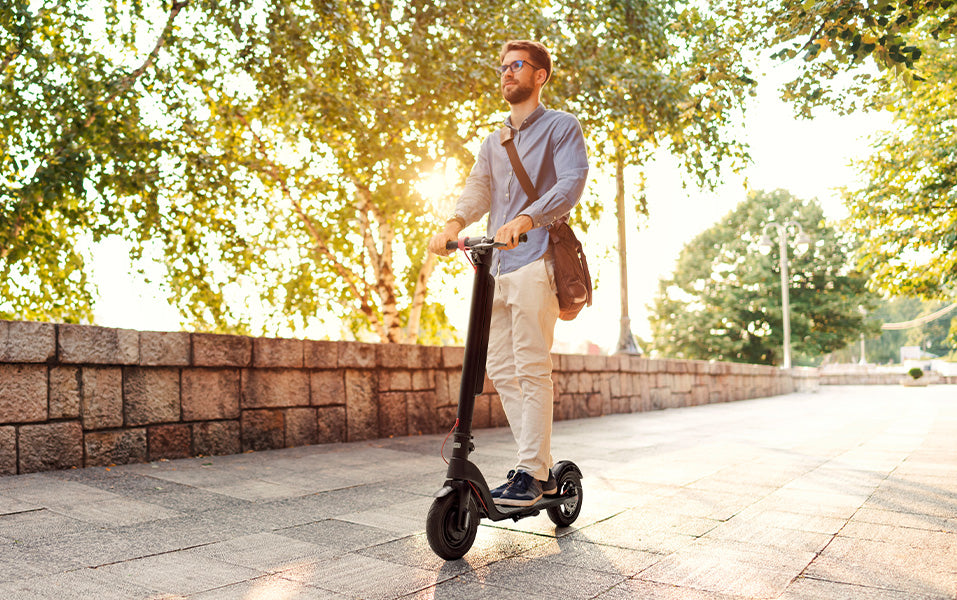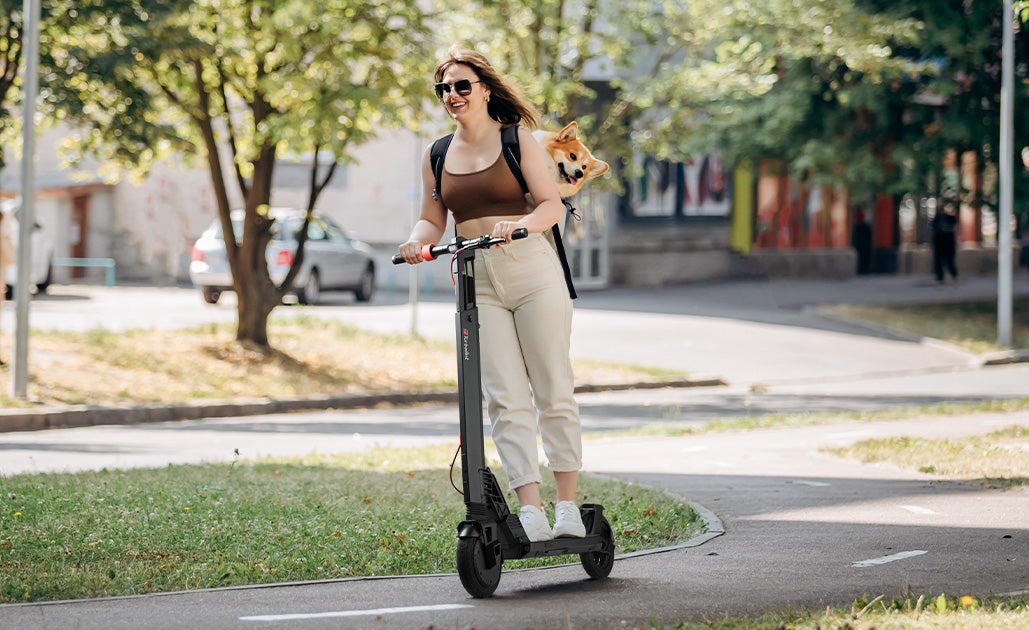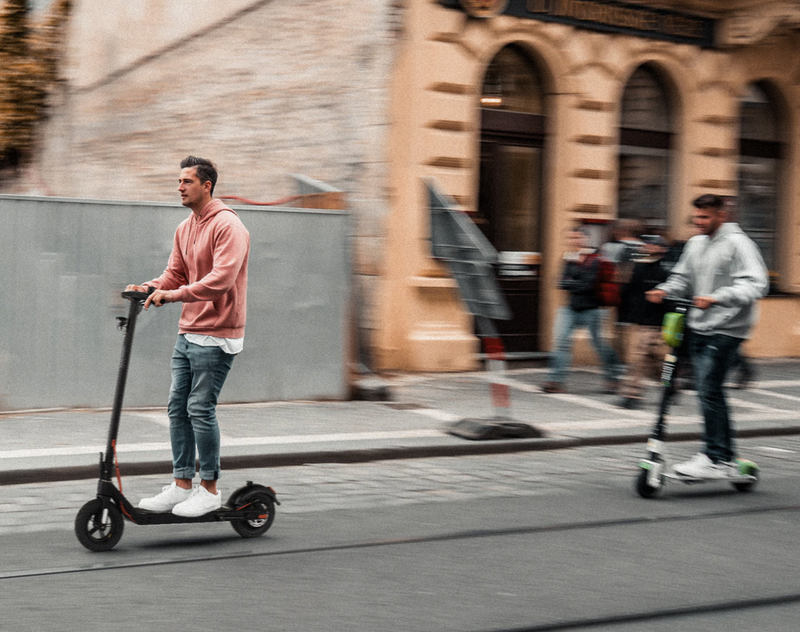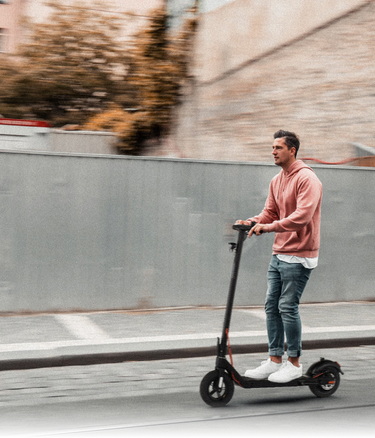When it comes to electric scooter performance and safety, one crucial yet often overlooked aspect is tire pressure. Tire pressure refers to the amount of air within the electric scooter tires, and it plays a fundamental role in the overall dynamics of the vehicle.
Incorrect tire pressure can lead to severe consequences for the rider and the scooter. Under-inflated tires result in reduced stability, and increased rolling resistance, leading to reduced battery life and overall inefficiency.
On the other hand, over-inflated tires can lead to a harsh and uncomfortable ride, affecting the scooter's ability to absorb shocks and bumps on uneven terrain.
To optimize electric scooter performance and guarantee rider safety, it is crucial to adhere to the manufacturer's recommended electric scooter tire pressure guidelines to prevent flat tires on electric scooters. Manufacturers determine the ideal tire pressure through rigorous testing and analysis.
In this comprehensive guide, we will explore the ins and outs of electric scooter tire pressure, detailing how to check and adjust it correctly.

Part 1. Factors Affecting Tire Pressure
The tire pressure of an electric scooter isn't a fixed value; a range of external factors can influence it. Temperature, for instance, has a significant impact. As temperatures change, the air inside the tires expands or contracts, leading to fluctuations in pressure. Colder temperatures can cause tire pressure to decrease, potentially resulting in under-inflation, while hotter temperatures can lead to over-inflation.
Terrain also plays a vital role. Riding on rough, uneven surfaces requires a different tire pressure than cruising on smooth pavements.
Load capacity, including the weight of the rider and any additional cargo, directly impacts tire pressure.
To adjust tire pressure based on these factors, riders should follow these tips accordingly:
- Regularly check tire pressure using a reliable pressure gauge before each ride.
- Refer to the manufacturer's guidelines for load capacity and adjust tire pressure accordingly.
- Experiment with different tire pressures based on terrain. Lower pressure for uneven surfaces and higher pressure for smoother paths can significantly improve ride quality.
- Consider your weight and make minor adjustments to tire pressure to find the right balance between stability and comfort.

Part 2. 4 Benefits of Maintaining Correct Tire Pressure
Ensuring that your electric scooter's tires are properly inflated goes beyond mere routine maintenance; it has a direct impact on your riding experience and the longevity of your scooter.
A. Improved Efficiency and Range:
One of the most significant advantages of maintaining correct tire pressure is improved efficiency, resulting in extended range for electric scooters. Properly inflated tires reduce rolling resistance, enabling the scooter to glide effortlessly with minimal effort from the motor.
B. Enhanced Safety and Stability:
Safety is paramount when riding an electric scooter, and tire pressure plays a crucial role in ensuring a secure journey. Adequate tire pressure ensures optimal grip on the road, improving traction and maneuverability.
C. Extended Lifespan of Tires and Battery:
Maintaining the correct tire pressure contributes to the longevity of both the scooter's tires and the battery. Under-inflated tires cause uneven wear patterns, leading to premature tire degradation and the need for frequent replacements.
D. Cost Savings and Reduced Maintenance:
Proper tire pressure not only helps save money on tire replacements but also reduces the need for costly repairs and maintenance.

Part 3. How to Check and Adjust Electric Scooter Tire Pressure
Checking your electric scooter's tire pressure is a simple but crucial task that should be performed regularly to ensure optimal performance and safety. Follow these steps to gauge your tire pressure accurately:
A. Step-by-step guide on checking tire pressure using a pressure gauge:
- Gather the necessary tools: Obtain a reliable tire pressure gauge suitable for your electric scooter's tire valve type. Most scooters use either a Schrader valve (similar to car tires) or a Presta valve (commonly found on bicycles).
- Check for manufacturer's recommendations: Refer to your electric scooter's user manual or the manufacturer's website to find the recommended tire pressure for your specific model.
- Prepare your scooter: Park your electric scooter on a flat, level surface and turn off the power to avoid any accidental movements during the process.
- Remove the valve cap: Unscrew the valve cap on the tire you wish to check. Set the cap aside in a safe place to avoid misplacing it.
- Attach the pressure gauge: Firmly press the pressure gauge onto the valve stem. If you are using a digital gauge, wait for the reading to stabilize. The measurement will be displayed on the gauge's dial if using an analog gauge.
- Read the tire pressure: Check the pressure reading displayed on the gauge. Compare this reading with the manufacturer's recommended tire pressure to determine if any adjustments are necessary.

B. The ideal pressure range for different electric scooter models:
The ideal tire pressure for electric scooters can vary based on the model, tire size, load capacity, and intended usage.
Typically, electric scooter manufacturers provide a recommended tire pressure range from 30 to 50 PSI (pounds per square inch) in their user manuals or on the scooter itself.
For example, TurboAnt X7 Max Folding Electric Scooter according to their user manual falls within the range of 30-32 psi (207-220 kPa) in hot weather and 34-36 psi (234-248 kPa) in cold seasons.
The TurboAnt V8 Long Range Electric Scooter is another impressive electric scooter in TurboAnt's lineup, offering comparable tire pressure requirements to its X7 Max counterpart. With the same recommended tire pressure range of 30-32 psi (207-220 kPa) in hot weather and 34-36 psi (234-248 kPa) in cold seasons, the TurboAnt V8 delivers a smooth and stable ride. While not as powerful as the X7 Max, the V8 remains a reliable and efficient option for daily commuting and urban exploration.
For those seeking a lightweight and nimble electric scooter, the M10 Lite Commuting Electric Scooter is an excellent choice. While its load capacity matches the TurboAnt X7 Max and V8 at 275 lbs., the M10 Lite offers a slightly different tire pressure recommendation. In hot weather, the ideal tire pressure is between 38-40 psi (262-276 kPa), and in cold seasons, it should be set between 40-45 psi (276-310 kPa).
C. The proper process of inflating or deflating tires as needed:
Inflating or deflating your electric scooter's tires to the correct pressure is a relatively simple process:
Inflating Tires:
- Use a Pump: Ensure you have a pump with a pressure gauge attached.
- Remove Valve Cap: Unscrew the valve cap from the valve stem.
- Attach the Pump: Firmly attach the pump nozzle to the valve stem.
- Add Air: Pump air into the tire while keeping an eye on the pressure gauge. Stop when the gauge reads the recommended pressure.
- Check Pressure: Detach the pump and use the gauge to confirm that the tire pressure matches the manufacturer's recommendation.
Deflating Tires:
- Use a Valve Tool: If the pressure is too high, you'll need to release air. Use a valve tool or a small screwdriver to press the valve's center pin.
- Release Air: Gently press down until you hear the hiss of air escaping. Check the pressure frequently to avoid over-deflation.
- Check Pressure: Once the pressure is within the recommended range, reattach the valve cap.
By paying close attention to tire pressure, you can unlock the full potential of your electric scooter. Embrace the benefits of improved efficiency, safety, and range while maintaining optimal tire pressure. Let us all actively preserve our electric scooters, ensuring they remain reliable and enjoyable companions for countless rides to come.





















